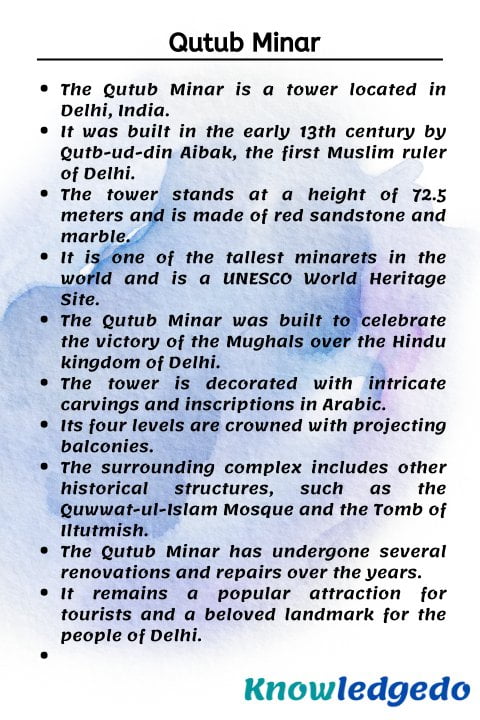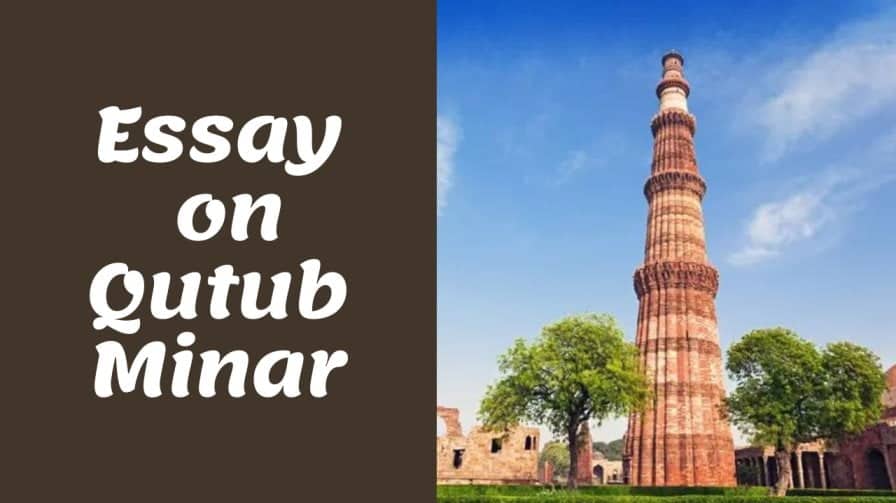Today, we are sharing an Essay on Qutub Minar in English This article can help students who are looking for information about Qutub Minar. This essay is very simple and easy to remember. The level of this essay is moderate so any student can write on this topic.
This article is generally useful for class 1 to class 12
essay on Qutub Minar
The Qutub Minar is a tower located in Delhi, India. It was built in the early 13th century by Qutb-ud-din Aibak, the first Muslim ruler of Delhi. The tower stands at a height of 72.5 meters and is made of red sandstone and marble. It is one of the tallest minarets in the world and is a UNESCO World Heritage Site.
The Qutub Minar was built to celebrate the victory of the Mughals over the Hindu kingdom of Delhi and is a testament to the architectural achievements of the Mughal empire. The tower is decorated with intricate carvings and inscriptions in Arabic, and its four levels are crowned with projecting balconies. The first three levels of the tower are made of red sandstone, while the fourth and final level is made of marble.
Visitors to the Qutub Minar can climb to the top of the tower for a breathtaking view of the surrounding area. The surrounding complex also includes several other historical structures, such as the Quwwat-ul-Islam Mosque, the Iron Pillar, and the Tomb of Iltutmish. The Qutub Minar is a must-see attraction for anyone interested in Indian history and culture.
The construction of the Qutub Minar was begun by Qutb-ud-din Aibak but was not completed until the reign of his successor, Iltutmish. The tower was originally built as a victory tower to celebrate the defeat of the Hindu kingdom of Delhi. However, over time it became a symbol of the power and strength of the Mughal empire.
The Qutub Minar has undergone several renovations and repairs over the years. In the 16th century, it was struck by lightning and the top two levels were destroyed. The Mughal emperor Shah Jahan later ordered the top two levels to be rebuilt in marble and added a balcony to the fourth level. In the 19th century, the British carried out further repairs and added a railing around the top of the tower.
Despite these renovations and repairs, the Qutub Minar remains a beautiful and impressive structure. Its intricate carvings and inscriptions, as well as its imposing height, make it a popular attraction for tourists and a beloved landmark for the people of Delhi. It is a symbol of the rich history and cultural diversity of India and is a must-see for anyone visiting the country.
Summary
The Qutub Minar is a tower located in Delhi, India. It was built in the early 13th century by Qutb-ud-din Aibak, the first Muslim ruler of Delhi. The tower stands at a height of 72.5 meters and is made of red sandstone and marble. It is one of the tallest minarets in the world and is a UNESCO World Heritage Site. The Qutub Minar was built to celebrate the victory of the Mughals over the Hindu kingdom of Delhi and is a testament to the architectural achievements of the Mughal empire. The tower is decorated with intricate carvings and inscriptions in Arabic, and its four levels are crowned with projecting balconies. The surrounding complex also includes other historical structures, such as the Quwwat-ul-Islam Mosque and the Tomb of Iltutmish. The Qutub Minar is a popular attraction for tourists and a beloved landmark for the people of Delhi.

FAQ
The Qutub Minar was built in the early 13th century, during the reign of the Delhi Sultanate.
The Qutub Minar was built by Qutb-ud-din Aibak, the first ruler of the Delhi Sultanate.
The Qutub Minar is made of red sandstone and marble, and is decorated with intricate carvings and inscriptions.
Yes, the Qutub Minar is a UNESCO World Heritage Site. It is a popular tourist attraction in Delhi, and is known for its beautiful architecture and rich cultural heritage.
